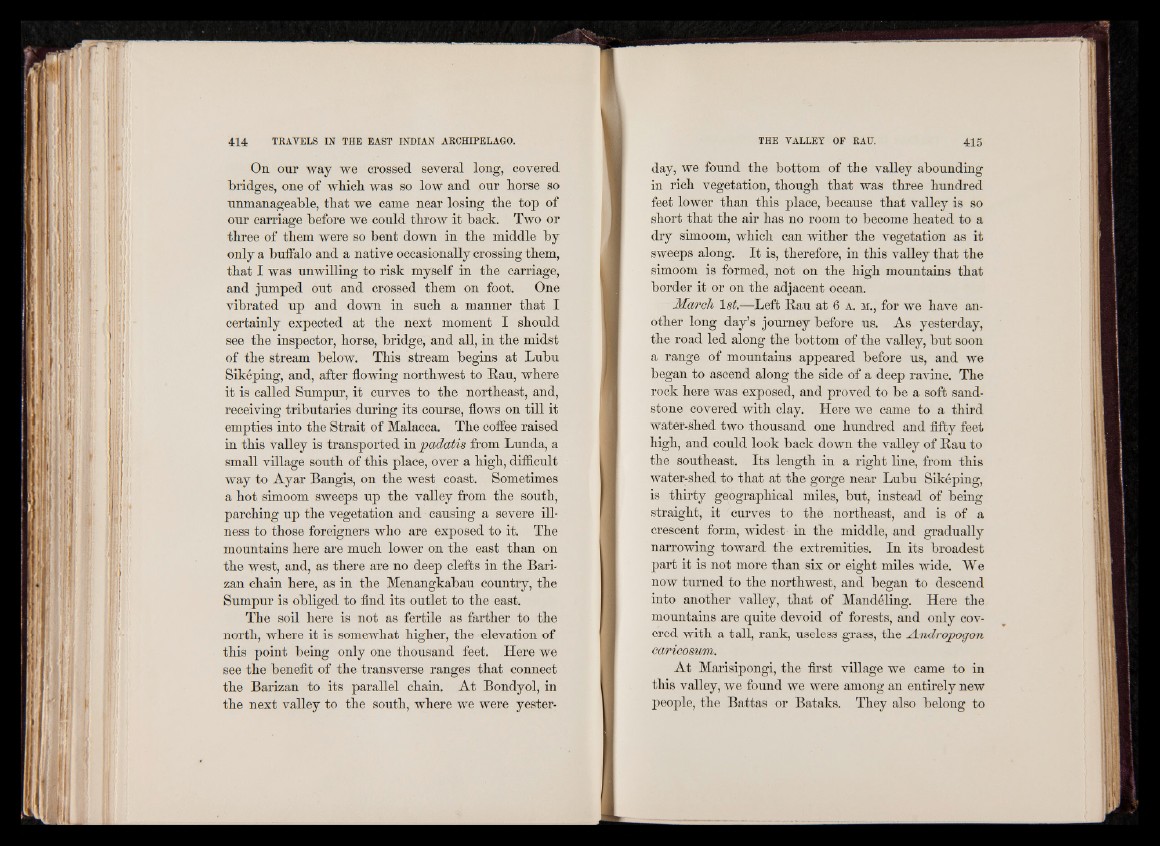
On onr way we crossed several long, covered
bridges, one of which was so low and our horse so
unmanageable, that we came near losing the top of
our carriage before we could throw it back. Two or
three of them were so bent down in the middle by
only a buffalo and a native occasionally crossing them,
that I was unwilling to risk myself in the carriage,
and jumped out and crossed them on foot. One
vibrated up and down in such a manner that I
certainly expected at the next moment I should
see the inspector, horse, bridge, and all, in the midst
of the stream below. This stream begins at Lubu
Sikeping, and, after flowing northwest to Bau, where
it is called Sumpur, it curves to the northeast, and,
receiving tributaries during its course, flows on till it
empties into the Strait of Malacca. The coffee raised
in this valley is transported in padatis from Lunda, a
small village south of this place, over a high, difficult
way to Ayar Bangis, on the west coast. Sometimes
a hot simoom sweeps up the valley from the south,
parching up the vegetation and causing a severe illness
to those foreigners who are exposed to it. The
mountains here are much lower on the east than on
the west, and, as there are no deep clefts in the Bari-
zan chain here, as in the Menangkabau country, the
Sumpur is obliged to find its outlet to the east.
The soil here is not as fertile as farther to the
north, where it is somewhat higher, the elevation of
this point being only one thousand feet. Here we
see the benefit of the transverse ranges that connect
the Barizan to its parallel chain. At Bondyol, in
the next valley to the south, where we were yesterday,
we found the bottom of the valley abounding
in rich vegetation, though that was three hundred
feet lower than this place, because that valley is so
short that the air has no room to become heated to a
dry simoom, which can wither the vegetation as it
sweeps along. It is, therefore, in this valley that the
simoom is formed, not on the high mountains that
border it or on the adjacent ocean.
March ls£— Left Bau at 6 a . m ., for we have another
long day’s journey before us. As yesterday,
the road led along the bottom of the valley, but soon
a range of mountains appeared before us, and we
began to ascend along the side of a deep ravine. The
rock here was exposed, and proved to be a soft sandstone
covered with clay. Here we came to a third
water-shed two thousand one hundred and fifty feet
high, and could look back down the valley of Bau to
the southeast. Its length in a right line, from this
water-shed to that at the gorge near Lubu Sikeping,
is thirty geographical miles, but, instead of being
straight, it curves to the northeast, and is of a
crescent form, widest- in the middle, and gradually
narrowing toward the extremities. In its broadest
part it is not more than six or eight miles wide. We
now turned to the northwest, and began to descend
into another valley, that of Mandating. Here the
mountains are quite devoid of forests, and only covered
with a tall, rank, useless grass, the Andropogon
caricosum.
At Marisipongi, the first village we came to in
this valley, we found we were among an entirely new
people, the Battas or Bataks. They also belong to